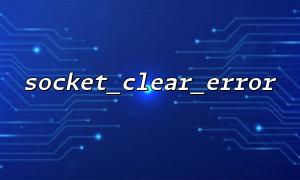Error handling is a very important part when writing socket services using PHP. The socket_clear_error() function is a tool used in PHP to clean up socket error status. Although it has simple functions, in actual development, encapsulating this function can bring a lot of convenience and improvement in code quality. This article will analyze from multiple perspectives why it is recommended to encapsulate the socket_clear_error() function when writing socket services.
socket_clear_error() is mainly used to clear the error state on a socket to avoid the error state affecting logical judgment or causing abnormal behavior in subsequent operations. Its prototype is as follows:
socket_clear_error($socket);
After the call, the error status on the $socket is cleared and the program can continue to perform subsequent operations.
Although it is simple to call socket_clear_error() directly, if the function is called directly in multiple places in the project, the error handling logic will be scattered and difficult to maintain. Through encapsulation, error cleaning logic can be centrally managed and exception scenarios can be handled uniformly, so as to facilitate subsequent modification and expansion.
For example, the encapsulation function not only cleans up errors, but also records logs, counts the number of errors, or automatically reconnects if necessary:
function clearSocketError($socket) {
// Logging before cleaning errors
error_log('Clearing socket error for socket: ' . intval($socket));
// Clear error
socket_clear_error($socket);
// Optional:Statistics the number of errors or other processing
}
The encapsulated function name clearly expresses the intention. Developers can just call clearSocketError() to clarify the meaning of the code without having to check the underlying details every time. For new members of the project, it is also more convenient to understand and use.
In the future, if the PHP version changes to socket_clear_error() , or if you want to replace it with more complex error cleaning logic, you just need to modify the encapsulation function without changing all call points one by one, reducing maintenance costs.
In socket programming, error state cleaning is a key step in preventing service abnormal disconnection. After encapsulating the function, it is easier for team members to remember that they must call this step when using it, reducing hidden bugs caused by omissions.
The following example demonstrates a simple encapsulation function and is called in the socket service loop:
function clearSocketError($socket) {
// Print the current error message,Convenient debugging
$error = socket_last_error($socket);
if ($error !== 0) {
$errMsg = socket_strerror($error);
error_log("Socket error before clearing: $errMsg ($error)");
}
socket_clear_error($socket);
}
$socket = socket_create(AF_INET, SOCK_STREAM, SOL_TCP);
// Assumptions socket Already connected or listened
while (true) {
// deal with socket Read and write operations...
// When an error is encountered,Clean up the error status
clearSocketError($socket);
// Continue business logic
}
Here, we call clearSocketError() in each loop to ensure that any error state is cleaned up in time and that the socket is in a healthy state.
Encapsulating the socket_clear_error() function seems simple, but the advantages it brings include:
Unified and centralized error handling logic
Improve code readability and maintenance
Supports subsequent expansion and compatibility tuning
Preventing the missing critical error cleanup steps
When writing robust PHP socket services, reasonably encapsulating error handling related functions is a good practice to ensure service stability and easy maintenance.













